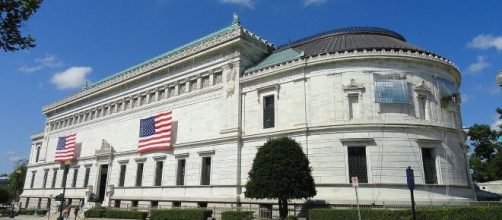It’s commonplace, like people pouring over their cell phones in restaurants: walking away from commitments. Sign of the times when even a front-runner for U.S. president disdains laws of the land.
The National Gallery of Art cancelled an agreement made in 2014 with the now defunct Corcoran Gallery, calling the reneging a “revision.”
Never mind what I said
So, even the way we talk about breaking a contract has changed. Presumably, now, if you, say, leave someone at the altar, chalk it up to a revision.
The promise was to show a selected 6,500 works of the Corcoran’s collection in the Corcoran’s glorious Beaux-Arts exhibit space.
But the deal is off. Farewell to views of great art at the oldest and largest non-federal museum in D.C.
Farewell, as well, to a legacy – its starring role in America’s culture wars of the 1980s and 1990s. Remember the congressional condemnation of Robert Mapplethorpe homoerotic photographs set to open at the Corcoran in 1989.
U.S. Representative Dick Armey of Texas and Senator Jesse Helms of North Carolina persuaded the Corcoran’s board of trustees to cancel the show the night before it was to open.
The controversy took a lot of turns and art went on trial. The Supreme Court considered bringing back a dictate requiring the National Endowment for the Arts to use a “decency standard” when doling out money.
And in 1990, a law actually went into effect requiring the NEA to take into consideration “standards of decency” and “respect for the diverse beliefs and values of the American public.”
Art and the U.S. Constitution
But this law was challenged by artists and a federal judge ruled it unconstitutional, citing “free-speech rights.” In 1996, the U.S. Circuit Court of Appeals concurred, saying: “Government funding does not justify government control of the content of speech.”
And here’s the thing. Government funding of art amounted to 1/100 of 1 percent of the federal budget. All this fuss for 64 cents a person per year!
Putting all that aside, one may wonders how important visual art is to the average American?
Are they such inveterate museum-goers that they have to be protected from what they might find objectionable?
Is museum-going such a popular American pastime that the issue had to end up in our courts, in our Congress? And speaking of Congress, did Jesse Helms ever really visit the Corcoran?
Controversy was not new to the Corcoran. The concept of suitability in art arose in 1934 when the U.S. government censored art even ahead of Nazi Germany.
A painting that hung at the Corcoran titled “Our Fleet's In”' by Paul Cadmus was taken down at the insistence of the U.S. Navy. Why? It showed sailors reveling with women. Now, no thanks for the National Gallery of Art, there won’t be any major shows at the Corcoran.
The building will be used by George Washington University art students.
The National Gallery will get to display the Corcoran collection. This can’t be how the story ends, can it? Far from a “revision,” it’s a rip-off!


